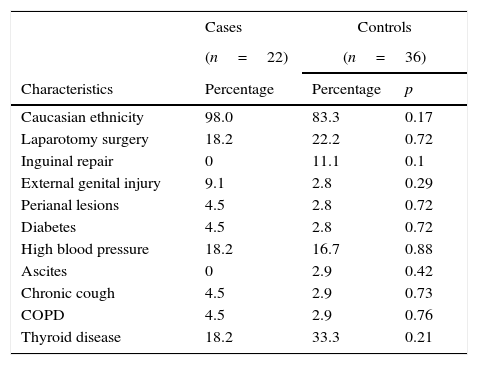To determine whether there are differences in the anthropometric measures of the perineum for women with symptomatic pelvic organ prolapse who are candidates for surgery, with or without urinary incontinence, and for patients without pelvic floor dysfunction. The main objective was to measure the anogenital distance in its 2 variants: anoclitoral and anofourchette. The anogenital distance appears to be determined prenatally and is influenced by the intrauterine hormonal environment. The secondary objective was to measure the length of the genital hiatus, the perineal body and the distance between the 2 ischial tuberosities.
Material and methodsAn observational case–control study was conducted with 58 patients. The cases (n=22) were patients with stages >II 2 in the Baden–Walker classification system. The controls were patients with normal pelvic floors. Measurements were performed with a digital caliper. The patients’ tocogynecological history, lifestyle habits and risk factors were recorded.
ResultsThe case patients had a significantly shorter anogenital anofourchette distance than that of the control patients (p=0.001), a significantly longer anogenital anoclitoral distance than the control patients (p=0.0001) and a significantly longer genital hiatus length than the control patients (p=0.02).
ConclusionsThis was an observational study with a small sample. We cannot determine whether the difference in these distances are caused by or are the result of this disease. Given that the anogenital distance appears to be determined prenatally, we question whether this changed distance could be a risk factor for developing pelvic floor dysfunction.
Explorar si hay diferencias en medidas antropométricas del periné en mujeres con prolapso de órganos pélvicos sintomático subsidiarias de tratamiento quirúrgico con/sin incontinencia urinaria y pacientes sin enfermedad de suelo pélvico. El objetivo principal fue medir la distancia anogenital en sus 2 variantes: ano-clítoris y ano-horquilla vulvar. La distancia anogenital parece estar determinada prenatalmente, influenciada por el ambiente hormonal intrauterino. Los objetivos secundarios fueron medir la longitud del hiato genital, el cuerpo perineal y la distancia entre ambas tuberosidades isquiáticas.
Material y métodosEstudio observacional caso-control con 58 pacientes. Los casos (n=22) fueron pacientes con estadios >ii 2 en la clasificación de Baden Walker. Los controles fueron pacientes con estática pélvica normal. Se realizaron las mediciones con un pie de rey digital. Se recogieron antecedentes tocoginecológicos, de hábitos de vida y factores de riesgo.
ResultadosLos casos tuvieron una distancia anogenital ano horquilla significativamente menor que las pacientes controles (p=0,001), una distancia anogenital ano clítoris significativamente mayor que las pacientes controles (p=0,0001) y una longitud del hiato genital significativamente más larga que las pacientes controles (p=0,02).
ConclusionesSe trata de una muestra pequeña y de un estudio observacional. No podemos determinar si la diferencia en estas distancias son causa o consecuencia de esta enfermedad. Ya que la distancia anogenital parece estar determinada prenatalmente nos planteamos si esta distancia alterada podría ser un factor de riesgo para el desarrollo de enfermedad del suelo pélvico.











